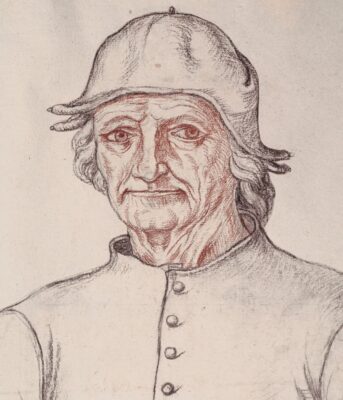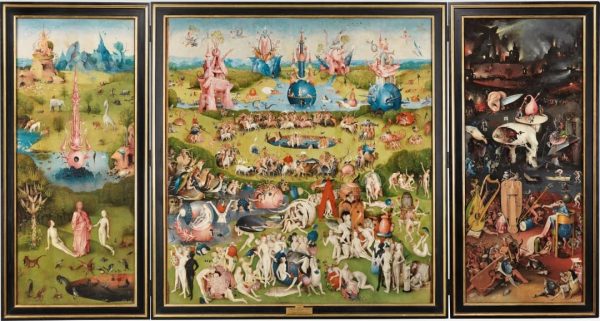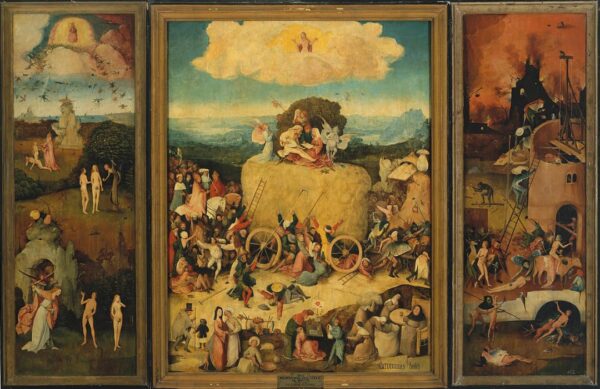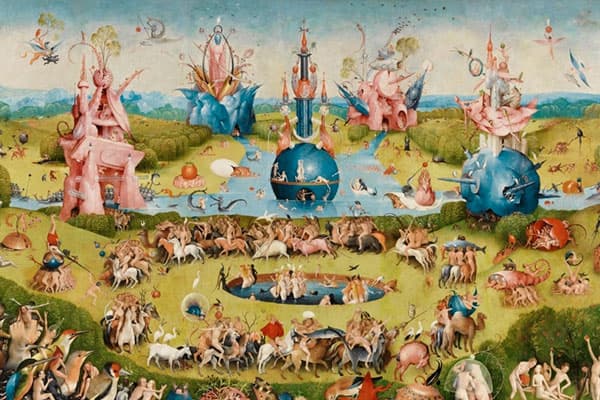Hieronymus Bosch
Of what did Bosch dream? Of Christ’s Passion,
André Breton
Of the wickedness and stupidity of the soldiers,
Of the vanity and transience of this earthly life,
Of Hell with its instruments of torture,
Of the temptation against which the holy men are capable of putting up little resistance.
Few “old” masters provoke as much fascination in the modern world as Hieronymus Bosch. A painter endowed with an overwhelming fantasy, original and unique in his time, creator of visual universes inhabited by naive sinners, seductive young women, and vengeful infernal demons, his works may have lost strength in their moralizing message, but their visual force continues to have an impact today.
Image: Attributed to Jacques Le Boucq: “Posthumous portrait of Hieronymus Bosch”, c.1500
Such is the fascination that Bosch’s imaginative work provoked during the 20th century that the painter is often regarded as a more than debatable precedent for modern movements and avant-gardes such as Surrealism. Walter Bosing, who considers that idea “anachronistic“, warns that “Bosch did not intend to evoke the viewer’s unconscious, but to convey certain moral and spiritual truths” (Walter Bosing, “Bosch”, 1973). In this sense, rather than as a precedent to later movements, Bosch could be seen as the culmination of the humorous and somewhat grotesque tradition of various Flemish miniatures of the 15th century which, as in Bosch’s works, reflect -again in Bosing’s words – “the hopes and fears of a Middle Ages that were drawing to a close“.
Little is known about the early life of Jheronimus van Aken / Hieronymus Bosch. His father was a painter, of modest fame, and it was in his workshop that the young Hieronymus must have been trained. It is possible that his earliest works date from the 1470s, and in fact an “Adoration of the Magi” preserved in the Metropolitan Museum of Art in New York is generally attributed to the artist, with an approximate date of around 1475. In the following decade he joined the religious congregation of the Illustrious Brotherhood of Our Lady. Other works of more or less clear authorship date from before the end of the century, such as “Christ Crowned with Thorns” in the National Gallery in London or “St. John the Baptist in Meditation” in the Lázaro Galdiano Foundation in Madrid, as well as his first known triptych, “Adoration of the Magi” in the Prado Museum.
Hieronymus Bosch: “The Garden of Earthly Delights”, c.1500-1505. Oil on panel, 220 x 386 cm. Prado Museum, Madrid ·· Hieronymus Bosch: “The Haywain Triptych”, c.1500-1516. Oil on panel, 135 x 200 cm. Prado Museum, Madrid
His most famous work, and one of the most admired paintings in Western art, is the triptych of “The Garden of Earthly Delights“ preserved in the Prado Museum, whose dating is subject to debate, although the date of 1500-1505 is generally accepted as the most probable. Around that time, Bosch received an important commission from the Duke of Burgundy, Philip “the Fair”, to execute a monumental “Last Judgment“. Although there are several triptychs by Bosch with this theme (in Vienna and Bruges), none of them match the description of this commission, so it is considered a lost work.
It is believed that some famous works date from the last years of Bosch’s life, such as the triptych of “The Temptations of St. Anthony“, now in the Museu Nacional de Arte Antiga in Lisbon, or the triptych of “The Haywain“, also in the Prado Museum.
It is known that the painter died in 1516, being buried on August 9 of that year. Today, the attribution of Bosch’s works remains problematic, as the artist’s success led to the appearance of numerous imitators and followers. King Philip II was an admirer of the work of Hieronymus Bosch, which is why today the best collection of his works is in the Prado Museum, including the aforementioned triptych of “The Garden of Earthly Delights“.
G. Fernández · theartwolf.com
Masterworks by Hieronymus Bosch
Follow us on:




